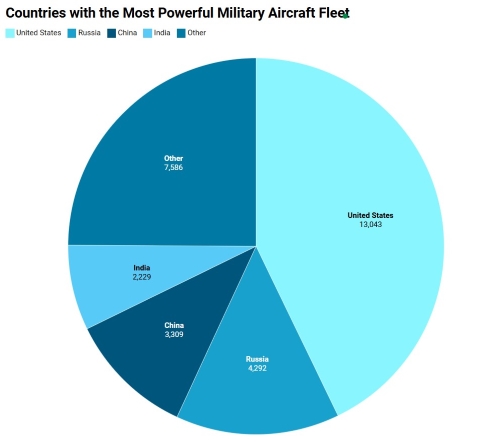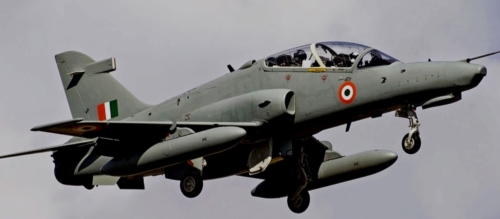In the ever-evolving realm of global security, air dominance remains a cornerstone of military strength. As we step into 2025, the focus has shifted from just the number of aircraft to the true capability and modernisation of military fleets. The World Directory of Modern Military Aviation (WDMMA) ranks nations using the TruVal Rating (TVR)—a metric that weighs combat effectiveness, logistical support, and technological advancement. With over 48,000 aircraft across 103 countries assessed, this list highlights the top 10 nations commanding the skies. From the United States’ unmatched fleet of 13,043 aircraft to India’s rapid rise in the rankings, each country is investing heavily in air power to ensure defence, deterrence, and global influence in an increasingly complex world.
But how does the Military Aircraft Fleet get an annual ranking at the global level?
The World Directory of Modern Military Aviation (WDMMA) Military Aircraft Fleet Annual Ranking is done, and WDMMA's annual ranking assesses global air forces based on TruVal Rating (TVR), which prioritises combat effectiveness, modernisation, logistical strength, and specialised aircraft over sheer numbers.
It evaluates factors like :
- Bomber fleets
- Close Air Support (CAS) aircraft
- Training units
- Domestic aerospace industry strength.
The United States Air Force (USAF) holds the highest TVR score of 242.9 due to its advanced and well-balanced fleet, strong domestic production, and global operational reach. It maintains strategic bombers, CAS aircraft, multirole fighter jets, transport aircraft, and specialised units, with continuous reinforcements enhancing its dominance.
What is the current inventory of WDMMA?
- Countries Evaluated: 103
- Air Services Included: 129 (covering Army, Navy, and Marine aviation branches where applicable)
- Total Aircraft Assessed: 48,082
What are the expenditure, strategic & advancement roles of the Military Aircraft Fleet?
- Military Expenditure: The global spending on military forces surged to $2.44 trillion in 2023, indicating a growing emphasis on modernising air forces worldwide.
- Air Forces' Strategic Role: Air superiority remains central to modern warfare, influencing a nation's ability to defend itself and project force globally.
- Technological Advancements: Countries continue to focus on developing advanced fighter jets, drone technologies, and air defence systems to maintain an edge in an evolving global security environment.
Top Countries with the Most Powerful Military Aircraft Fleet in 2025

Here’s a breakdown of the nations leading the charge in air power, ranked according to the size and capability of their military aircraft fleets:
| Rank | Country | Aircraft Fleet Size (2025) |
| 1 | United States | 13,043 |
| 2 | Russia | 4,292 |
| 3 | China | 3,309 |
| 4 | India | 2,229 |
| 5 | South Korea | 1,592 |
| 6 | Japan | 1,443 |
| 7 | Pakistan | 1,399 |
| 8 | Egypt | 1,093 |
| 9 | Turkey | 1,083 |
| 10 | France | 976 |
Detailed Overview of the Top Military Aircraft Fleet Countries:
1. United States
- Fleet Size: 13,043 Aircraft
- Overview: The United States remains the undisputed leader in military air power, commanding nearly 40% of global defence spending. The U.S. Air Force boasts cutting-edge fighter jets, bombers, and drones, making it the cornerstone of American military operations worldwide.
- Significance: The U.S. Air Force plays a crucial role in both defensive and offensive military strategies, maintaining a global presence that extends beyond its borders.
2. Russia
- Fleet Size: 4,292 Aircraft
- Overview: Russia's air force ranks second, with a fleet that includes a range of modern fighter jets, bombers, and strategic aircraft. The country focuses on maintaining a robust defence capability, particularly within its sphere of influence in Eastern Europe and Central Asia.
- Strategic Importance: The Russian air force is essential to maintaining the nation’s deterrence capabilities and asserting its power within regional and global conflicts.
3. China
- Fleet Size: 3,309 Aircraft
- Overview: China has made significant advancements in its air force, focusing on state-of-the-art fighter jets and the development of unmanned aerial vehicles (UAVs). With rapid expansion and modernisation, China is steadily enhancing its role in global defence.
- Growing Influence: China’s air power is crucial in asserting dominance within the Asia-Pacific region and enhancing its global military footprint.
4. India
- Fleet Size: 2,229 Aircraft
- Overview: India’s air force has grown considerably over the past decade, integrating advanced fighter aircraft and air defence systems. It is a key player in the Indian Ocean region and has developed a reputation for precision military operations.
- Role in Global Security: India’s air capabilities are critical for regional security, especially given its geopolitical rivalry with neighbouring nations.
5. South Korea
- Fleet Size: 1,592 Aircraft
- Overview: South Korea’s air force is equipped with some of the most advanced aircraft in the world. With a focus on air defense and strategic deterrence, it plays a key role in the security of the Korean Peninsula.
- Significance: The country’s air fleet is vital in defending against regional threats, particularly from North Korea.
6. Japan
- Fleet Size: 1,443 Aircraft
- Overview: Japan’s air force is highly advanced, with cutting-edge technology and state-of-the-art aircraft. The Japanese Self-Defense Forces prioritize air superiority and quick-response capabilities.
- Strategic Role: Japan’s air capabilities are central to its regional stability and play a key role in its partnerships with global defense alliances.
7. Pakistan
- Fleet Size: 1,399 Aircraft
- Overview: Pakistan’s air force maintains a diverse fleet designed to defend against external and internal threats. It continues to modernize its fleet with the acquisition of advanced fighter jets and enhanced defence systems.
- Geopolitical Context: Pakistan’s air power is crucial in countering India’s military strength and asserting its security in a tense region.
8. Egypt
- Fleet Size: 1,093 Aircraft
- Overview: Egypt has a strong air force, which is supported by advanced fighter jets and air defence systems. The nation plays a prominent role in North African security and regional defence initiatives.
- Regional Influence: Egypt’s air power extends its influence across the Middle East and North Africa, ensuring the stability of the region.
9. Turkey
- Fleet Size: 1,083 Aircraft
- Overview: Turkey has a modern and versatile air force, with substantial investment in fighter aircraft and drone technologies. As a member of NATO, Turkey plays an important role in European defence.
- Strategic Impact: Turkey’s air capabilities are vital for its geopolitical influence in both Europe and the Middle East.
10. France
- Fleet Size: 976 Aircraft
- Overview: France’s air force is a leading power in Europe, equipped with advanced aircraft and a strong focus on global military operations. The French Air Force is a key player in NATO and other international defence initiatives.
- Global Operations: France maintains a high level of readiness, participating in military interventions worldwide, particularly in Africa and the Middle East.
How Is India Growing Its Military Aircraft Fleet?
India's Aircraft Fleet has emerged as one of the strongest in the world, placing 4th globally in fleet size. The Indian Air Force continues to modernise its aircraft, incorporating cutting-edge fighter jets and air defence systems. The Indian Air Force’s role is pivotal in maintaining regional security, particularly in light of tensions with neighbouring countries. Through rapid upgrades and strategic operations, India ensures its place among the top military air powers.

Source: Indianairforce
Why the Size of Military Aircraft Fleets Matters
The size and technological capability of an air force are crucial for several reasons:
- National Defence: A powerful air force can effectively deter threats and safeguard a nation’s borders.
- Global Power Projection: Countries with large fleets can project power globally, participating in peacekeeping and military operations worldwide.
- Technological Superiority: Air forces with state-of-the-art technology are better equipped to defend against modern threats and secure air dominance.
- Geopolitical Influence: A large and advanced fleet gives nations the ability to influence regional and global security dynamics.
Conclusion
In 2025, the United States continues to dominate with an unmatched fleet of 13,043 aircraft, while countries like Russia, China, and India are making strides to close the gap with impressive modernisation efforts. The rankings reflect not just the size but also the technological superiority of these fleets, shaping the global security landscape. As air power continues to be a significant element of modern military strategy, these nations are poised to influence geopolitical outcomes worldwide.
Comments
All Comments (0)
Join the conversation